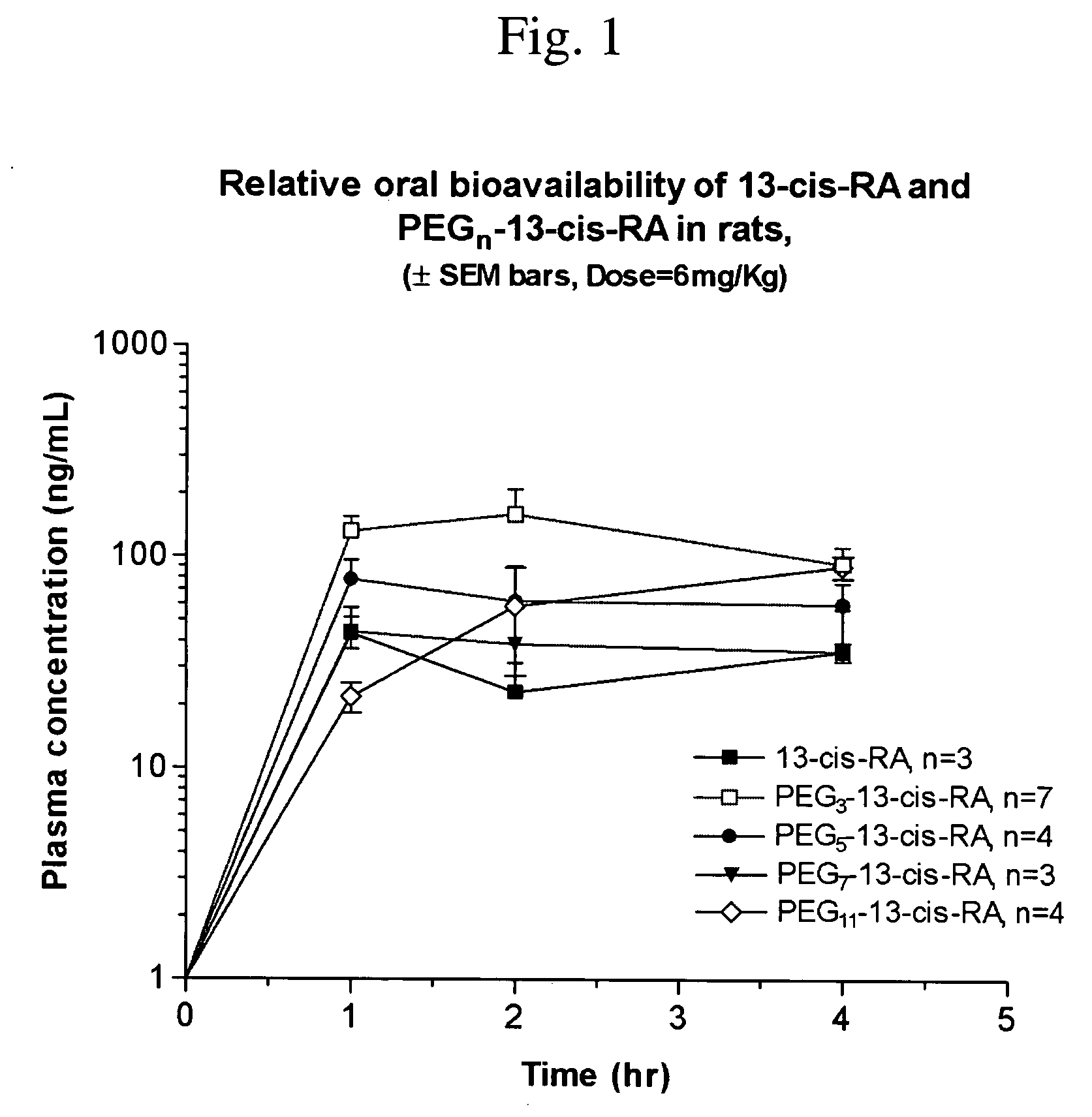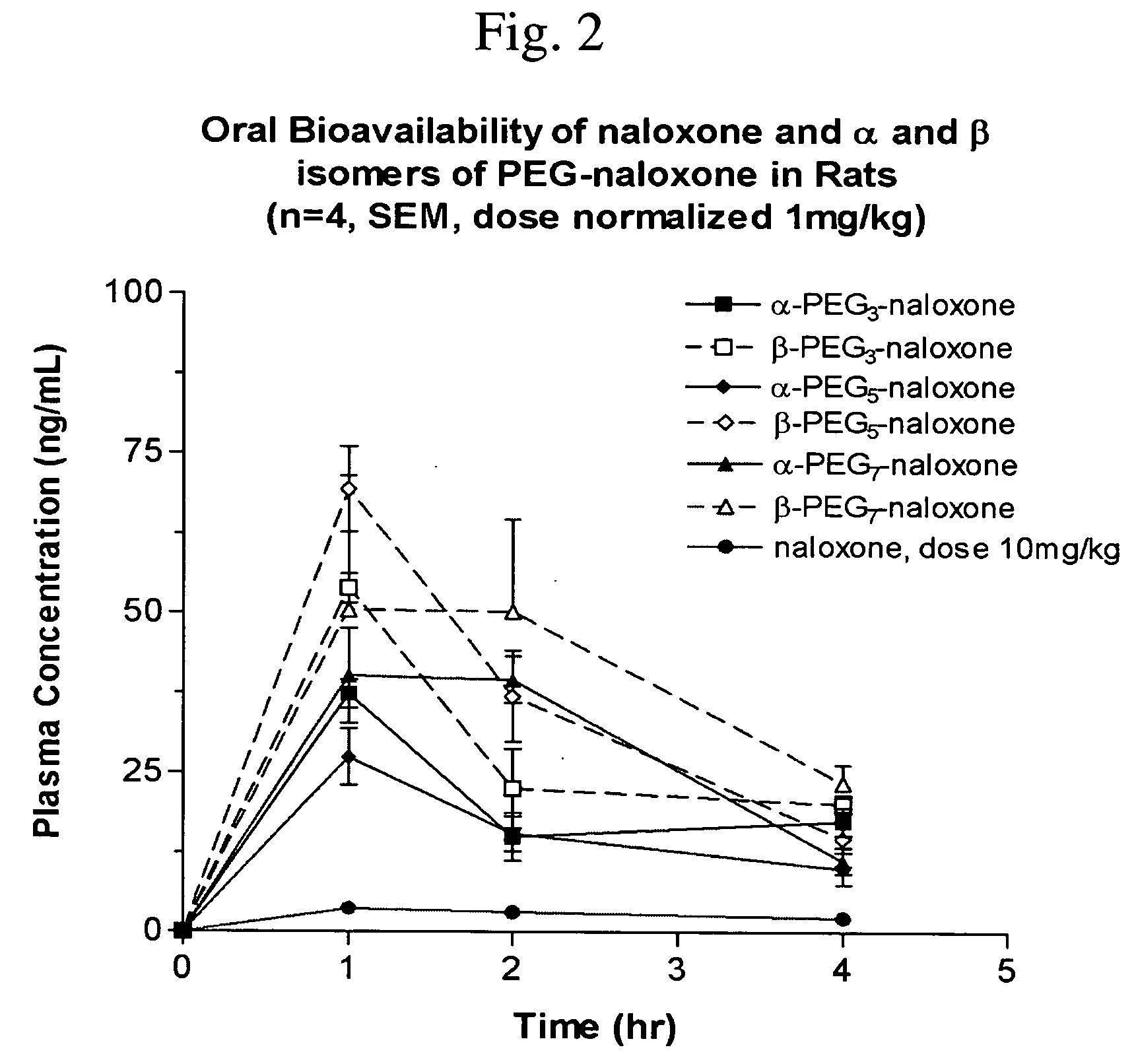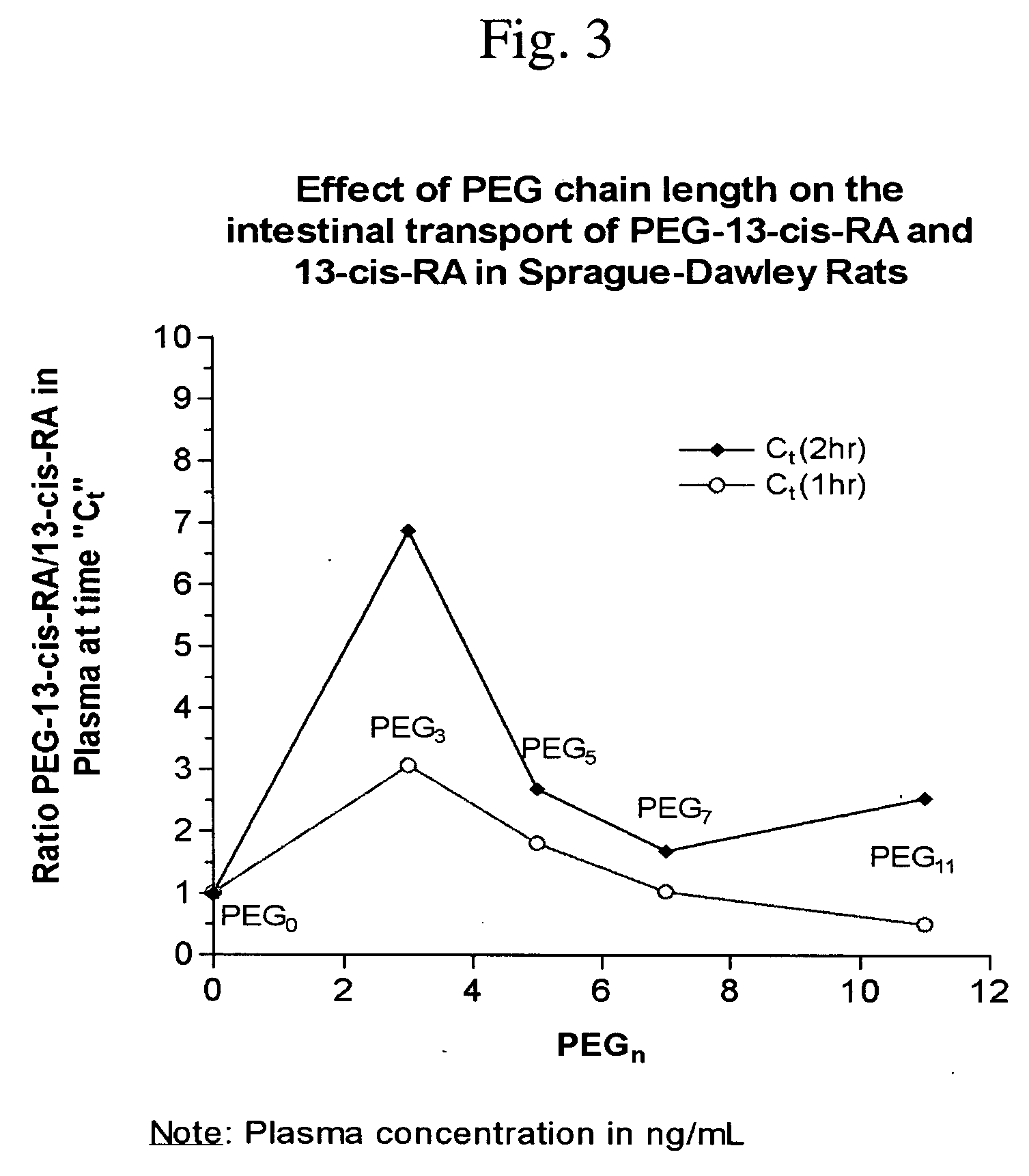Chemically modified small molecules
a small molecule, chemical technology, applied in the direction of organic chemistry, nervous disorders, drug compositions, etc., can solve the problems of serious side effects, direct conflict with the properties required for optimal target affinity and administration, and impracticality of oral administration
- Summary
- Abstract
- Description
- Claims
- Application Information
AI Technical Summary
Benefits of technology
Problems solved by technology
Method used
Image
Examples
example 1
Synthesis of CH3(OCH2CH2)3—NH-13-cis-retinamide (PEG3-13-cis-RA)
[0235] PEG3-13-cis-RA was prepared. The overview of the synthesis is provided below.
0.1085 grams of CH3(OCH2CH2)3—NH2 (0.6656mmoles), 0.044 grams of 1-hydroxybenzyltriazole (“HOBT,” 0.3328 mmoles), and 0.200 g of 13-cis-retinoic acid (“13-cis-RA,” 0.6656 mmoles) were dissolved in 10 mL of benzene. To this solution was added 0.192 grams of 1,3-dicyclohexylcarbodiimide (“DCC,” 0.9318mmoles) and the reaction mixture was stirred overnight at room temperature. The reaction mixture was filtered and the solvent was removed using rotary evaporation. The crude product was further dried under vacuum, dissolved in 20 mL of dichloromethane, and the organic phase was washed twice with 15 mL of deionized water. The organic phase was dried over Na2SO4, filtered, and the solvent removed by rotary evaporation. To the recovered product was added 2 drops of dichloromethane containing 50 ppm butylated hydroxytoluene and the product was...
example 2
Synthesis of CH3—(OCH2CH2)7—NH-13-cis-retinamide (PEG7-13-cis-RA)
[0236] 0.2257 grams of CH3(OCH2CH2)7—NH2 (0.6656 mmoles), 0.044 grams of 1-hydroxybenzyltriazole (0.3328 mmoles), and 0.200 grams of 13-cis-retinoic acid (0.6656 mmoles) were dissolved in 10 mL of benzene. To this solution was added 0.192 g 1,3-dicyclohexylcarbodiimide (0.9318 mmoles) and the resulting reaction mixture was stirred overnight at room temperature. The reaction mixture was filtered, the solvent removed using rotary evaporation, and the product dried under vacuum. The product was dissolved in 20 mL dichloromethane and the solution was washed twice with 15 mL deionized water. The organic phase was dried over Na2SO4, filtered, and the solvent removed using rotary evaporation. To the recovered product was added 2 drops of dichloromethane containing 50 ppm butylated hydroxytoluene, and the product was dried under vacuum. Yield 0.426 g. 1H NMR (DMSO): δ 1.01 (s, 2 CH3), 1.68 (s, CH3), 3.5 (br m, PEG), 6.20 (m, ...
example 3
Synthesis of CH3—(OCH2CH2)11—NH-13-cis-retinamide (PEG11-13-cis-RA)
[0238] 0.349 grams of CH3(OCH2CH2)11—NH2 (0.6789 mmoles), 0.044grams of 1-hydroxybenzyltriazole (0.3328 mmoles), and 0.204 grams of 13-cis-retinoic acid (0.6789 mmoles) was dissolved in 10 mL of benzene. To this solution was added 0.192 g 1,3-dicyclohexylcarbodiimide (0.9318 mmoles) and the reaction mixture was stirred overnight at room temperature. The reaction mixture was filtered and the solvent distilled off using rotary evaporation. The product was dried under vacuum and dissolved in 20 mL dichloromethane. The solution was washed twice with 15 mL of deionized water and the organic phase dried over Na2SO4. The solution was filtered and the solvent was distilled off by rotary evaporation. To the recovered product was added 2 drops of dichloromethane containing 50 ppm butylated hydroxytoluene, and the product was dried under vacuum. Yield 0.541 g. 1H NMR (DMSO): δ 1.01 (s, 2 CH3), 1.68 (s, CH3), 3.5 (br m, PEG), 6...
PUM
| Property | Measurement | Unit |
|---|---|---|
| Length | aaaaa | aaaaa |
| Fraction | aaaaa | aaaaa |
| Mass | aaaaa | aaaaa |
Abstract
Description
Claims
Application Information
 Login to View More
Login to View More - R&D
- Intellectual Property
- Life Sciences
- Materials
- Tech Scout
- Unparalleled Data Quality
- Higher Quality Content
- 60% Fewer Hallucinations
Browse by: Latest US Patents, China's latest patents, Technical Efficacy Thesaurus, Application Domain, Technology Topic, Popular Technical Reports.
© 2025 PatSnap. All rights reserved.Legal|Privacy policy|Modern Slavery Act Transparency Statement|Sitemap|About US| Contact US: help@patsnap.com



